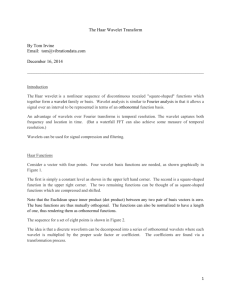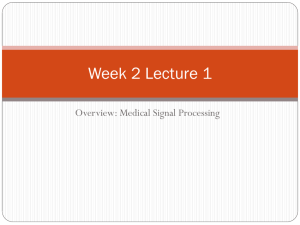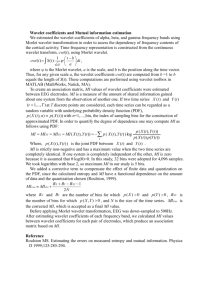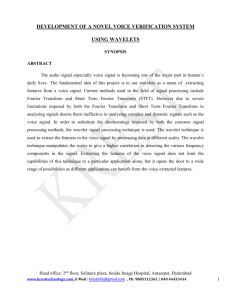Wavelet
advertisement
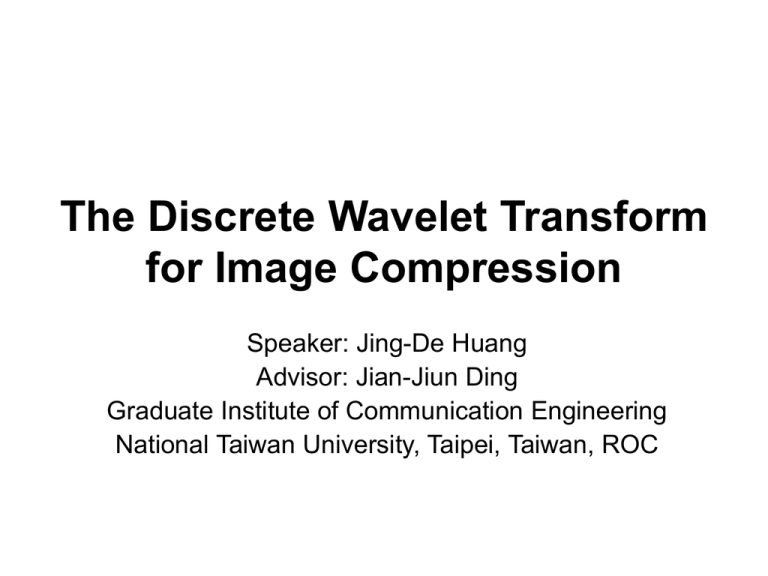
The Discrete Wavelet Transform
for Image Compression
Speaker: Jing-De Huang
Advisor: Jian-Jiun Ding
Graduate Institute of Communication Engineering
National Taiwan University, Taipei, Taiwan, ROC
Outline
•
•
•
•
•
•
•
Subband Coding
Multiresolution Analysis
Discrete Wavelet Transform
The Fast Wavelet Transform
Wavelet Transforms in Two Dimension
Image Compression
Simulation Result
2
1. Subband Coding
h0(n)
2
y0 (n)
2
Analysis
x ( n)
h1(n)
0
2
Synthesis
y1 (n)
H1 ( )
H1 ( )
Low band
High band
/2
g0(n)
2
+
xˆ (n)
g1(n)
3
1. Subband Coding
• Cross-modulated
Z-transform :
H 0 ( z )G0 ( z ) H1 ( z )G1 ( z ) X ( z )
12 H 0 ( z )G0 ( z ) H1 ( z )G1 ( z ) X ( z )
Xˆ ( z )
1
2
For error-free reconstruction Xˆ ( z ) X ( z )
H 0 ( z )G0 ( z ) H1 ( z )G1 ( z ) 0
H 0 ( z )G0 ( z ) H1 ( z )G1 ( z ) 2
For finite impulse response (FIR) filters and ignoring the delay
g0 (n) (1) n h1 (n)
g1 (n) (1) n 1 h0 (n)
FIR synthesis filters are cross-modulated copies of the analysis filters
with one (and only one) being sign reversed.
4
1. Subband Coding
• Biorthogonal
g 0 (k ), h0 (2n k ) (n),
g 0 (k ), h1 (2n k ) 0
g1 (k ), h1 (2n k ) (n),
g1 (k ), h0 (2n k ) 0
hi (2n k ), g j (k ) (i j ) (n), i, j {0,1}
The analysis and synthesis filter impulse responses of all two-band,
real-coefficient, perfect reconstruction filter banks are subject to the
biorthogonality constraint
5
1. Subband Coding
• Orthonormal
– gi (n), g j (n 2m) (i j ) (m), i, j {0,1}
– one solution of biorthogonal
– used in the fast wavelet transform
– the relationship of the four filter is :
g1 (n) (1) n g0 (2 K 1 n)
, 2K denotes the number of coefficients
g1 (n) is related to g 0 (n)
hi (n) gi (2 K 1 n), i {0,1}
h1 (n), h2 (n) is time-reversed versions of g1 (n), g 2 (n), respectively
6
2. Multiresolution Analysis
• Expansion of a signal f (x) :
f ( x) kk ( x) k : real-valued expansion coefficients
k
k ( x) : real-valued expansion functions
k k ( x), f ( x) k* ( x) f ( x)dx
k ( x): the dual function of k ( x)
If k ( x) is an orthonormal basis for V , then k ( x) k ( x)
If the expansion is unique, the k ( x) are called basis functions.
The function space of the expansion set k ( x) : V span k ( x )
k
If k ( x) are not orthonormal but are an orthogonal basis for V ,
then the basis funcitons and their duals are called biorthogonal.
0 , j k
Biorthogonal: j ( x), k ( x) jk
1 , j k
7
2. Multiresolution Analysis
• Scaling function
j ,k ( x) 2 j / 2 (2 j x k ), for k Z and ( x) L2 R
The subspace spanned over k for any j : V j span j ,k ( x)
k
The scaling functions of any subspace can be built from
double-resolution copies of themselves. That is,
( x) h (n) 2 (2 x n)
n
where the coefficients are called scaling function coefficients.
8
2. Multiresolution Analysis
• Requirements of scaling function:
1. The scaling function is orthogonal to its integer translates.
2. The subspaces spanned by the scaling function at low scales are
nested within those spanned at higher scales.
That is
V
V1 V0 V1 V2
V
3. The only function that is common to all V j is f ( x) 0.
That is
V 0
4. Any function can be represented with arbitrary precision.
That is,
2
V L R
9
2. Multiresolution Analysis
• Wavelet function
spans the difference between any two adjacent scaling subspaces
V j and V j 1
j ,k ( x) 2 j / 2 (2 j x k ) for all k Z that spans the space W j
where W span ( x)
j
j ,k
k
The wavelet function can be expressed as a weighted sum of
shifted, double-resolution scaling functions. That is,
( x) h (n) 2 (2 x n)
n
where the h (n) are called the wavelet function coefficients.
It can be shown that h (n) (1) h (1 n)
n
10
2. Multiresolution Analysis
V2 V1 W1 V0 W0 W1
V1 V0 W0
W1
W0
V0
Figure 2 The relationship between scaling and wavelet function spaces.
The scaling and wavelet function subspaces in Fig. 2 are related by
V j 1 V j W j
We can express the space of all measurable, square-integrable function as
L2 R V0 W0 W1 W2
or L2 R
W2 W1 W0 W1 W2
11
3 Discrete Wavelet Transform
• Wavelet series expansion
f ( x) c j0 (k ) j0 ,k ( x) d j (k ) j ,k ( x)
k
j j0 k
where j0 is an arbitrary starting scale
c j0 (k ) f ( x), j0 ,k ( x) f ( x) j0 ,k ( x)dx
called the approximation or scaling coefficients
d j (k ) f ( x), j ,k ( x) f ( x) j ,k ( x)dx
called the detail or wavelet coefficients
12
3 Discrete Wavelet Transform
• Discrete Wavelet Transform
the function f(x) is a sequence of numbers
1
f ( x)
M
1
W
(
j
,
k
)
(
x
)
k 0 j0 ,k
M
W ( j, k )
j j0 k
j ,k
( x)
where j0 is an arbitrary starting scale
1
W ( j0 , k )
M
M 1
f ( x)
x 0
j0 , k
( x)
called the approximation or scaling coefficients
1
W ( j , k )
M
M 1
f ( x)
x 0
j,k
( x)
called the detail or wavelet coefficients
13
4 The Fast Wavelet Transform
• Fast Wavelet Transform (FWT)
– computationally efficient implementation of the DWT
– the relationship between the coefficients of the DWT at adjacent
scales
– also called Mallat's herringbone algorithm
– resembles the twoband subband coding scheme
14
4 The Fast Wavelet Transform
Scaling x by 2j, translating it by k, and
letting m = 2k + n
( x) h (n) 2 (2 x n)
n
(2 j x k ) h (n) 2 2(2 j x k ) n h (m 2k ) 2 2 j 1 x m
n
m
Similarity
,
j
(2 x k ) h (m 2k ) 2 (2 j 1 x m)
m
Consider the DWT. Assume
1
W ( j0 , k )
M
1
M
( x) ( x) and ( x) ( x)
M 1
f ( x)
x 0
j0 , k
( x)
h (m 2k )
( x) h (n) 2 (2 x n)
n
2 (2 j0 x m)
m
15
4 The Fast Wavelet Transform
1
W ( j , k )
M
1
M
M 1
f ( x) j ,k ( x)
f ( x)2 j / 2 (2 j x k )
x 0
j ,k ( x) 2 j / 2 (2 j x k )
x
j/2
j 1
f
(
x
)2
h
(
m
2
k
)
2
(2
x
m
)
x
m
1
( j 1) / 2
j 1
h (m 2k )
f
(
x
)2
(2
x
m
)
m
M x
1
M
h (m 2k )W ( j 1, m)
m
Similarity,
W ( j, k ) h (m 2k )W ( j 1, m)
m
16
4 The Fast Wavelet Transform
W ( j , k ) h (n) W ( j 1, n)
W ( j , k ) h (n) W ( j 1, n)
n 2 k , k 0
n 2 k ,k 0
Figure 3 An FWT analysis filter bank.
17
4 The Fast Wavelet Transform
Figure 4 An FWT-1 synthesis filter bank.
By subband coding theorem, perfect reconstrucion for two-band
orthonormal filters requires gi (n) hi (n) for i = {0, 1}.
That is, the synthesis and analysis filters must be time-reversed
versions of one another. Since the FWT analysis filter are
h0 (n) h (n) and h1 (n) h (n) , the required FWT-1 synthesis filters
are g 0 (n) h0 (n) h (n) and g1 (n) h1 (n) h (n) .
18
Wavelet Transform vs. Fourier Transform
• Fourier transform
– Basis function cover the entire signal range,
varying in frequency only
• Wavelet transform
– Basis functions vary in frequency (called “scale”)
as well as spatial extend
• High frequency basis covers a smaller area
• Low frequency basis covers a larger area
19
Wavelet Transform vs. Fourier Transform
Time-frequency distribution for (a) sampled data, (b) FFT, and (c) FWT basis
20
5 Wavelet Transforms in Two Dimension
Figure 5 The two-dimensional FWT the analysis filter.
21
5 Wavelet Transforms in Two Dimension
W ( j , m, n) WH ( j, m, n)
W ( j 1, m, n)
WV ( j , m, n) WD ( j, m, n)
two-dimensional decomposition
W ( j , m, n) WH ( j, m, n)
W ( j 1, m, n)
WV ( j , m, n) WD ( j, m, n)
Figure 6 Two-scale of two-dimensional decomposition
22
5 Wavelet Transforms in Two Dimension
23
5 Wavelet Transforms in Two Dimension
Figure 7 The two-dimensional FWT the synthesis filter bank.
24
Common Wavelet Filters
• Haar: simplest, orthogonal, not very good
• Daubechies 8/8: orthogonal
• Daubechies 9/7: bi-orthogonal
most commonly used if numerical
reconstruction errors are acceptable
• LeGall 5/3: bi-orthogonal, integer operation,
can be implemented with integer operations
only, used for lossless image coding
25
6 Image Compression
image
Wavelet
coding
Quantization
• Quantization
Entropy
coding
bitstream
W j (m, n)
q j (m, n) sign( y j (m, n))
j
– uniform scalar quantization
– separate quantization step-sizes for each subband
• Entropy coding
– Huffman coding
– Arithmetic coding
26
7 Simulation Result
I1
encoder
C
decoder
I2
I1: Original image with width W and height H
C: Encoded jpeg stream from I1
I2: Decoded image from C
CR (Compression Ratio) = sizeof(I1) / sizeof(C)
H
RMS (Root mean square error) =
W
I1 ( x, y) I 2 ( x, y) /( H W )
2
y 1 x 1
27
7 Simulation Result
Original image
DCT-based
image compression
CR = 11.2460
RMS = 4.1316
Wavelet-based
image compression
CR = 10.3565
RMS = 4.0104
28
7 Simulation Result
Original image
DCT-based
image compression
CR = 27.7401
RMS = 6.9763
Wavelet-based
image compression
CR = 26.4098
RMS = 6.8480
29
7 Simulation Result
Original image
DCT-based
image compression
CR = 53.4333
RMS = 10.9662
Wavelet-based
image compression
CR = 51.3806
RMS = 9.6947
30
Reference
•
•
•
•
R. C. Gonzolez, R. E. Woods, "Digital Image
Processing second edition", Prentice Hall, 2002.
R. C. Gonzolez, R. E. Woods, S. L. Eddins, "Digital
Image Processing Using Matlab", Prentice Hall, 2004.
T. Acharya, A. K. Ray, "Image Processing: Principles
and Applications", John Wiley & Sons, 2005.
B. E. Usevitch, 'A Tutorial on Modern Lossy Wavelet
Image Compression: Foundations of JPEG 2000',
IEEE Signal Processing Magazine, vol. 18, pp. 22-35,
Sept. 2001.
31


